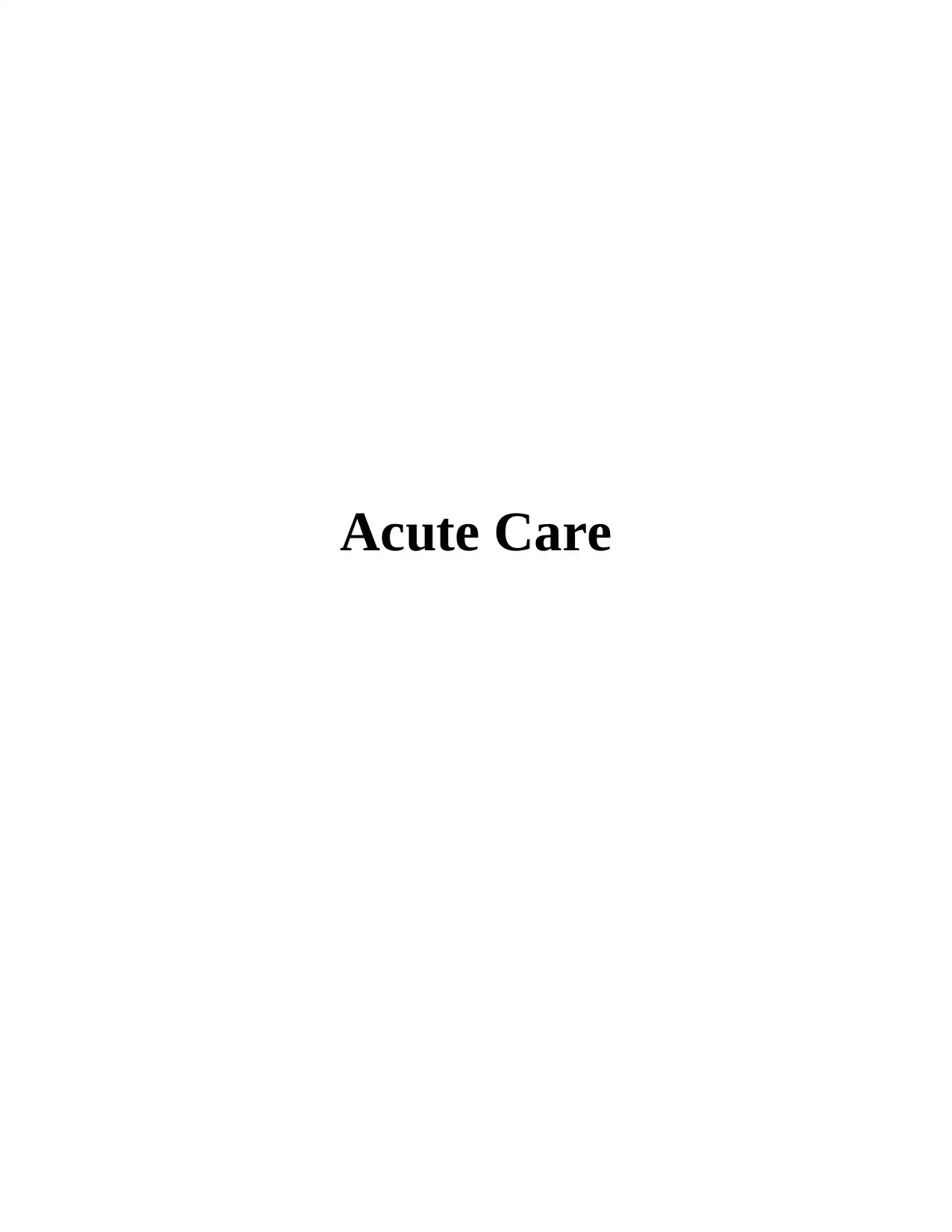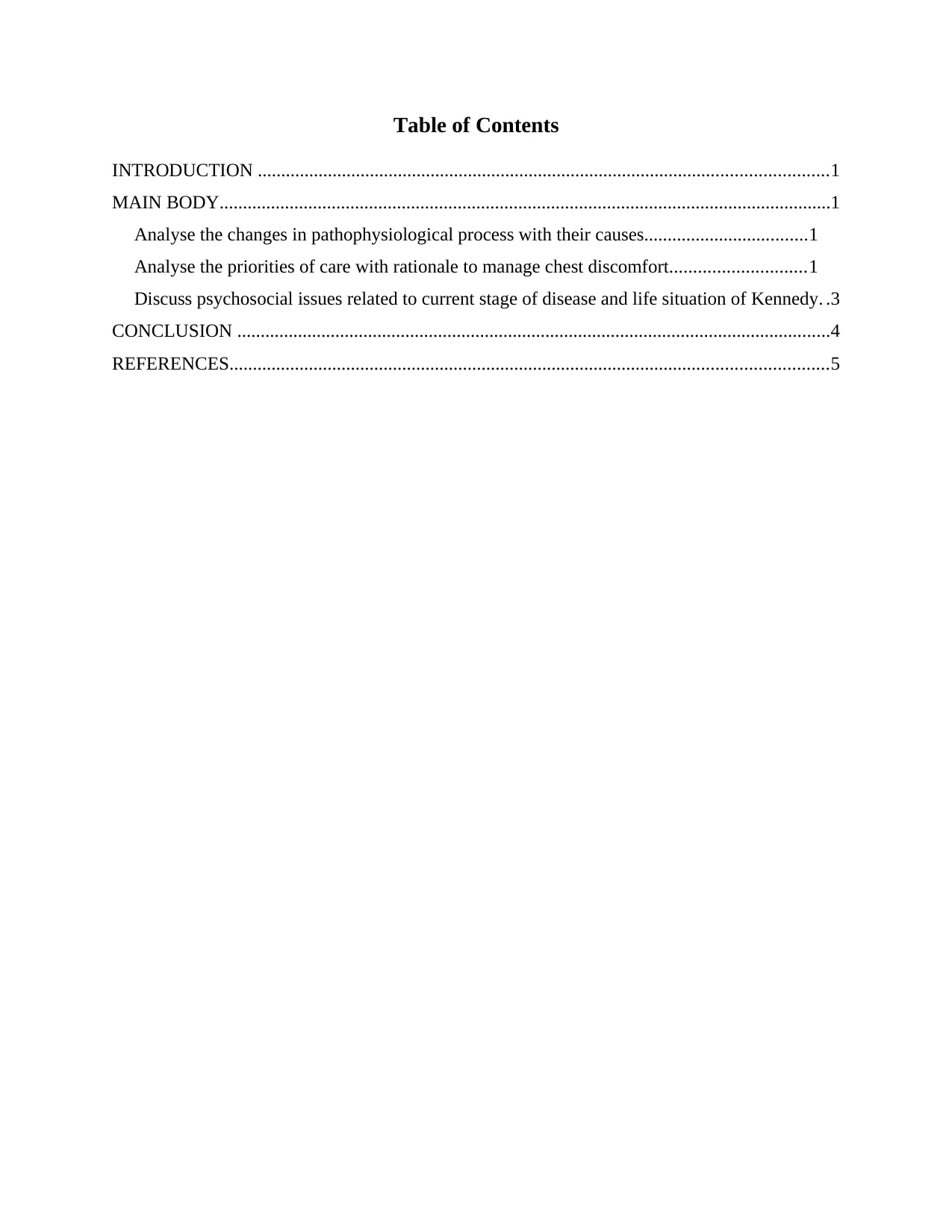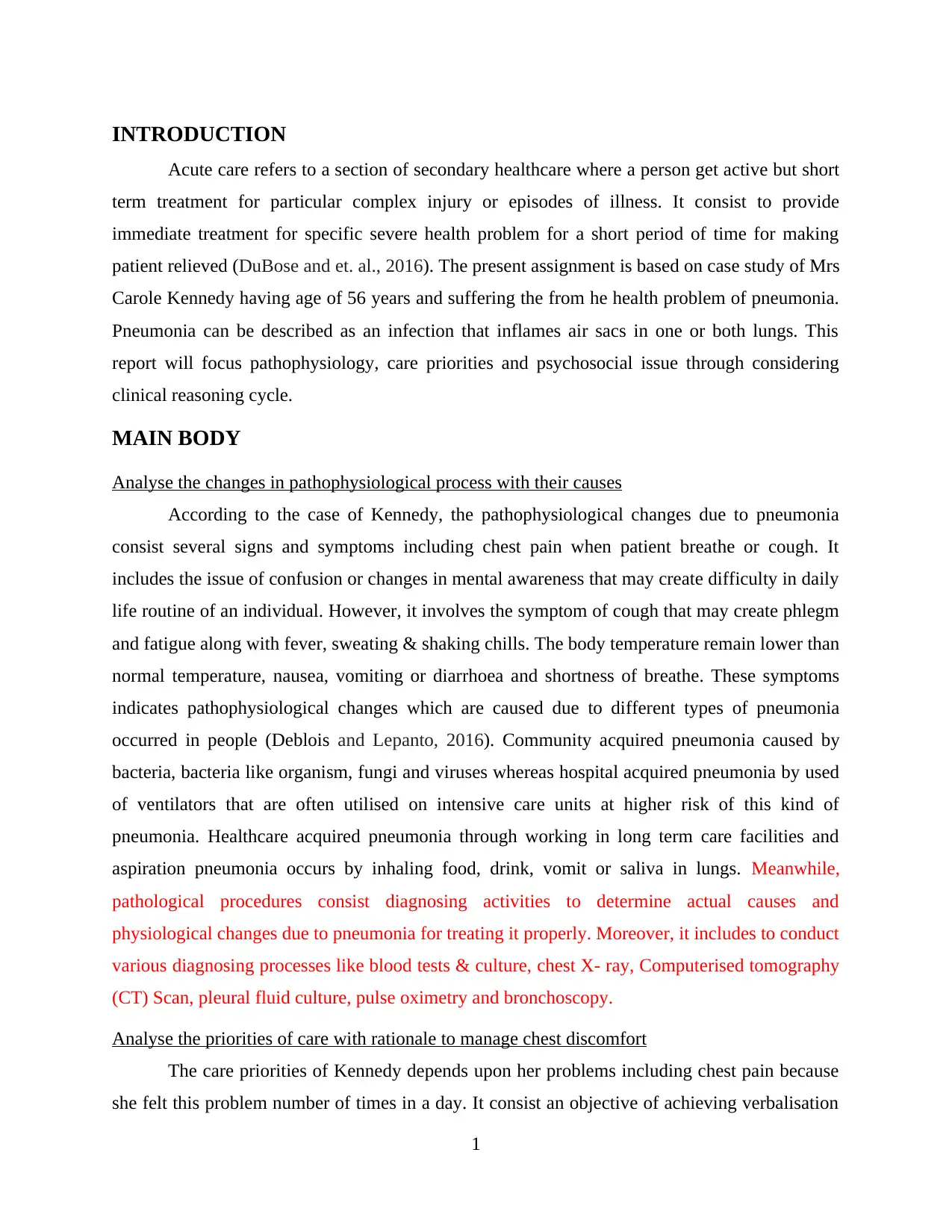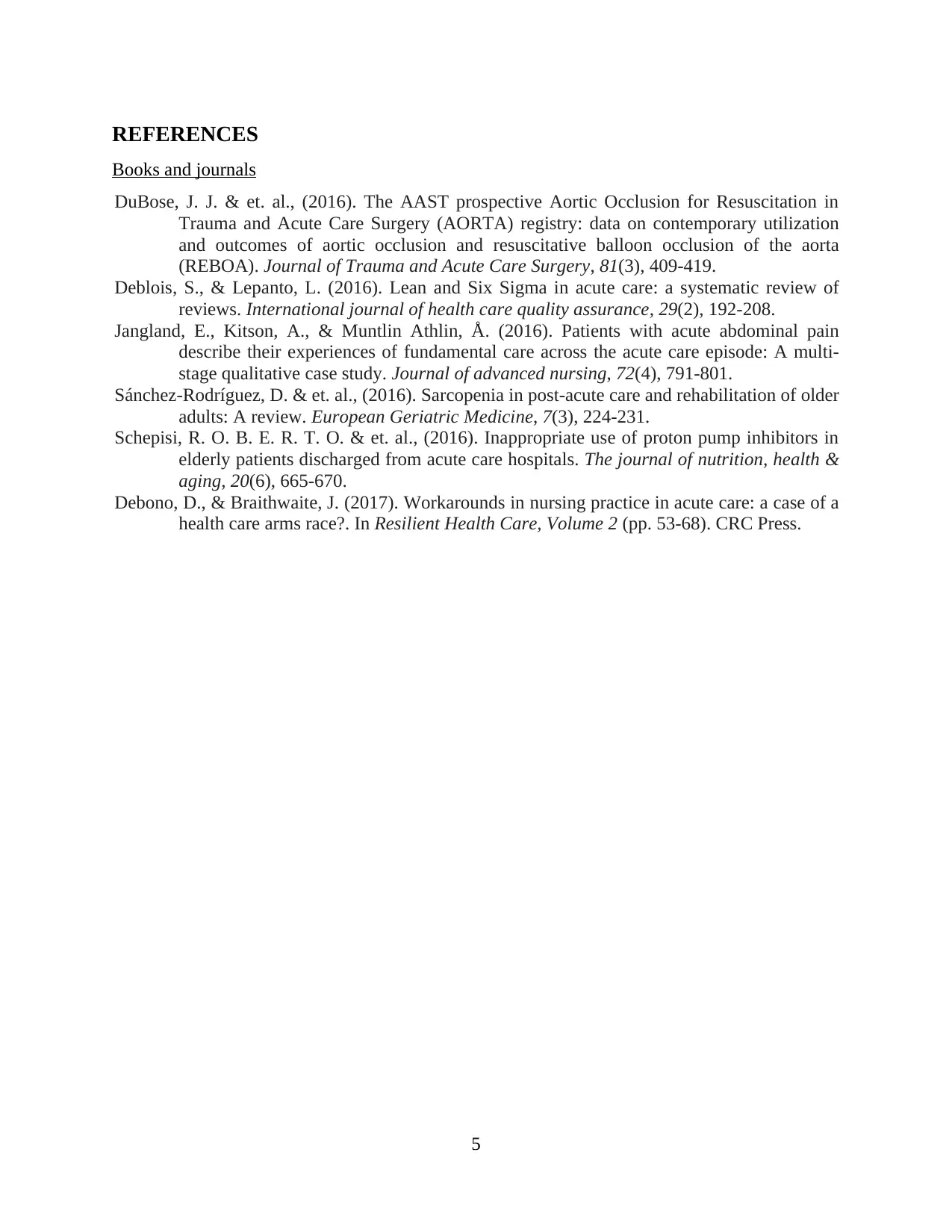Analysis of Pneumonia in Acute Care: Kennedy's Case Study Report
VerifiedAdded on 2021/02/19
|8
|1760
|28
Report
AI Summary
This report presents an analysis of a case study involving a 56-year-old patient, Mrs. Carole Kennedy, diagnosed with pneumonia in an acute care setting. The report delves into the pathophysiological changes associated with pneumonia, including symptoms such as chest pain, confusion, cough, fatigue, fever, and shortness of breath, and discusses their underlying causes. It then prioritizes care strategies for managing chest discomfort, detailing nursing interventions with rationales, such as assessing pain characteristics, monitoring vital signs, providing comfort measures, and administering medications. Furthermore, the report explores the psychosocial issues faced by Kennedy, addressing her loneliness, financial constraints, and reluctance to seek help, linking these issues to her current stage of disease and life situation. The conclusion summarizes the findings, emphasizing the importance of acute care in managing complex illnesses and the significance of comprehensive patient care, including physical, emotional, and social aspects. The report references relevant literature to support its analysis.

Acute Care
Paraphrase This Document
Need a fresh take? Get an instant paraphrase of this document with our AI Paraphraser

Table of Contents
INTRODUCTION ..........................................................................................................................1
MAIN BODY...................................................................................................................................1
Analyse the changes in pathophysiological process with their causes...................................1
Analyse the priorities of care with rationale to manage chest discomfort.............................1
Discuss psychosocial issues related to current stage of disease and life situation of Kennedy. .3
CONCLUSION ...............................................................................................................................4
REFERENCES................................................................................................................................5
INTRODUCTION ..........................................................................................................................1
MAIN BODY...................................................................................................................................1
Analyse the changes in pathophysiological process with their causes...................................1
Analyse the priorities of care with rationale to manage chest discomfort.............................1
Discuss psychosocial issues related to current stage of disease and life situation of Kennedy. .3
CONCLUSION ...............................................................................................................................4
REFERENCES................................................................................................................................5

⊘ This is a preview!⊘
Do you want full access?
Subscribe today to unlock all pages.

Trusted by 1+ million students worldwide

INTRODUCTION
Acute care refers to a section of secondary healthcare where a person get active but short
term treatment for particular complex injury or episodes of illness. It consist to provide
immediate treatment for specific severe health problem for a short period of time for making
patient relieved (DuBose and et. al., 2016). The present assignment is based on case study of Mrs
Carole Kennedy having age of 56 years and suffering the from he health problem of pneumonia.
Pneumonia can be described as an infection that inflames air sacs in one or both lungs. This
report will focus pathophysiology, care priorities and psychosocial issue through considering
clinical reasoning cycle.
MAIN BODY
Analyse the changes in pathophysiological process with their causes
According to the case of Kennedy, the pathophysiological changes due to pneumonia
consist several signs and symptoms including chest pain when patient breathe or cough. It
includes the issue of confusion or changes in mental awareness that may create difficulty in daily
life routine of an individual. However, it involves the symptom of cough that may create phlegm
and fatigue along with fever, sweating & shaking chills. The body temperature remain lower than
normal temperature, nausea, vomiting or diarrhoea and shortness of breathe. These symptoms
indicates pathophysiological changes which are caused due to different types of pneumonia
occurred in people (Deblois and Lepanto, 2016). Community acquired pneumonia caused by
bacteria, bacteria like organism, fungi and viruses whereas hospital acquired pneumonia by used
of ventilators that are often utilised on intensive care units at higher risk of this kind of
pneumonia. Healthcare acquired pneumonia through working in long term care facilities and
aspiration pneumonia occurs by inhaling food, drink, vomit or saliva in lungs. Meanwhile,
pathological procedures consist diagnosing activities to determine actual causes and
physiological changes due to pneumonia for treating it properly. Moreover, it includes to conduct
various diagnosing processes like blood tests & culture, chest X- ray, Computerised tomography
(CT) Scan, pleural fluid culture, pulse oximetry and bronchoscopy.
Analyse the priorities of care with rationale to manage chest discomfort
The care priorities of Kennedy depends upon her problems including chest pain because
she felt this problem number of times in a day. It consist an objective of achieving verbalisation
1
Acute care refers to a section of secondary healthcare where a person get active but short
term treatment for particular complex injury or episodes of illness. It consist to provide
immediate treatment for specific severe health problem for a short period of time for making
patient relieved (DuBose and et. al., 2016). The present assignment is based on case study of Mrs
Carole Kennedy having age of 56 years and suffering the from he health problem of pneumonia.
Pneumonia can be described as an infection that inflames air sacs in one or both lungs. This
report will focus pathophysiology, care priorities and psychosocial issue through considering
clinical reasoning cycle.
MAIN BODY
Analyse the changes in pathophysiological process with their causes
According to the case of Kennedy, the pathophysiological changes due to pneumonia
consist several signs and symptoms including chest pain when patient breathe or cough. It
includes the issue of confusion or changes in mental awareness that may create difficulty in daily
life routine of an individual. However, it involves the symptom of cough that may create phlegm
and fatigue along with fever, sweating & shaking chills. The body temperature remain lower than
normal temperature, nausea, vomiting or diarrhoea and shortness of breathe. These symptoms
indicates pathophysiological changes which are caused due to different types of pneumonia
occurred in people (Deblois and Lepanto, 2016). Community acquired pneumonia caused by
bacteria, bacteria like organism, fungi and viruses whereas hospital acquired pneumonia by used
of ventilators that are often utilised on intensive care units at higher risk of this kind of
pneumonia. Healthcare acquired pneumonia through working in long term care facilities and
aspiration pneumonia occurs by inhaling food, drink, vomit or saliva in lungs. Meanwhile,
pathological procedures consist diagnosing activities to determine actual causes and
physiological changes due to pneumonia for treating it properly. Moreover, it includes to conduct
various diagnosing processes like blood tests & culture, chest X- ray, Computerised tomography
(CT) Scan, pleural fluid culture, pulse oximetry and bronchoscopy.
Analyse the priorities of care with rationale to manage chest discomfort
The care priorities of Kennedy depends upon her problems including chest pain because
she felt this problem number of times in a day. It consist an objective of achieving verbalisation
1
Paraphrase This Document
Need a fresh take? Get an instant paraphrase of this document with our AI Paraphraser

of patient regarding relief and make them understand about non pharmacological intervention of
pain relief.
Nursing interventions with rationale for pain management
However, it includes certain nursing interventions of assessment with rationale including
assessing the pain features such as stabbing, sharp and constant along with relevant changes like
character, location & intensity of pain because it helps to analyse complications of pneumonia in
case of Kennedy i.e. pericarditis and endocarditis. It also involves the activity of monitoring vital
symptoms on regular basis that are important to determine heart rate or blood pressure changes
which can shows about pain experienced by patient (Sánchez-Rodríguez and et. al., 2016). The
therapeutic interventions consist to render comfort measures like changing position, quite music,
massage and back rubs by encouraging utilisation of relaxation & breathing exercises that is
significant in patient involvement which encourage their independence as well as enhance sense
of well being.
Basically, it is necessary to provide effective and frequent oral hygiene which is helpful
to maintain mucous membranes that reduce risk of relevant discomfort. Meanwhile, it is essential
to assist and instruct patient in chest splinting methods at the time of coughing episodes that is
significant to aid in controlling discomfort of chest while improving the effectiveness of cough
effort. In addition to this, it is necessary to conduct administration of antitussive as indicated and
do not suppress the productive cough along with using moderate quantity to analgesics for
relieving pleuritic pain (Schepisi and et. al., 2016). It will facilitate increase comfort level and
coughing is essential for secretions and suppressing the same may cause delay resolution of
pneumonia in given case of Kennedy. Moreover, it consist the administration of analgesics as per
prescription of physician and make patient understand to tale relevant medications before
complications of discomfort takes place. It will helpful to relief the pain and improve ability of
given patient for deep breathing and coughing along with preventing peak levels of pain.
Ineffective breathing in case of Kennedy requires several therapeutic nursing
interventions to improve her condition. Firstly, maintain proper body alignment for maximum
breathing pattern that improves maximum chest expansion & lung excursion. Secondly, it
includes to highlight slow inhalation, use incentive spirometer and passive exhalation which are
significant to aid slow respirations in patients who are tachypneic and prolonged expiration
prevents air trapping (Debono and Braithwaite, 2017). It consist to maintain clear airway through
2
pain relief.
Nursing interventions with rationale for pain management
However, it includes certain nursing interventions of assessment with rationale including
assessing the pain features such as stabbing, sharp and constant along with relevant changes like
character, location & intensity of pain because it helps to analyse complications of pneumonia in
case of Kennedy i.e. pericarditis and endocarditis. It also involves the activity of monitoring vital
symptoms on regular basis that are important to determine heart rate or blood pressure changes
which can shows about pain experienced by patient (Sánchez-Rodríguez and et. al., 2016). The
therapeutic interventions consist to render comfort measures like changing position, quite music,
massage and back rubs by encouraging utilisation of relaxation & breathing exercises that is
significant in patient involvement which encourage their independence as well as enhance sense
of well being.
Basically, it is necessary to provide effective and frequent oral hygiene which is helpful
to maintain mucous membranes that reduce risk of relevant discomfort. Meanwhile, it is essential
to assist and instruct patient in chest splinting methods at the time of coughing episodes that is
significant to aid in controlling discomfort of chest while improving the effectiveness of cough
effort. In addition to this, it is necessary to conduct administration of antitussive as indicated and
do not suppress the productive cough along with using moderate quantity to analgesics for
relieving pleuritic pain (Schepisi and et. al., 2016). It will facilitate increase comfort level and
coughing is essential for secretions and suppressing the same may cause delay resolution of
pneumonia in given case of Kennedy. Moreover, it consist the administration of analgesics as per
prescription of physician and make patient understand to tale relevant medications before
complications of discomfort takes place. It will helpful to relief the pain and improve ability of
given patient for deep breathing and coughing along with preventing peak levels of pain.
Ineffective breathing in case of Kennedy requires several therapeutic nursing
interventions to improve her condition. Firstly, maintain proper body alignment for maximum
breathing pattern that improves maximum chest expansion & lung excursion. Secondly, it
includes to highlight slow inhalation, use incentive spirometer and passive exhalation which are
significant to aid slow respirations in patients who are tachypneic and prolonged expiration
prevents air trapping (Debono and Braithwaite, 2017). It consist to maintain clear airway through
2

motivating given person to mobilise their own secretions by successful coughing that is
important to adequate clearance of secretions. However, always remain with Kennedy at the time
of acute episodes of respiratory distress that is essential to decrease anxiety and oxygen demand
of an individual. Meanwhile, it is necessary to enhance rest durations frequently and make
patient learn to pace activity which prevent condition of worsening shortness of breathe.
Moreover, it is significant to educate an individual about proper coughing, splinting and
breathing in order to allow sufficient mobilisation of secretions.
Goals of pain management interventions involves to make patient comfortable with
verbalise relief or control of pain at level less than 3 to 4 utilising a rating scale of 0 to 10. it
consist relaxed sleeping and engaging in activities and understand significance of non-
pharmacological interventions for pain relief. The expected outcomes for nursing interventions
for ineffective breathing includes to make an individual able to maintain their ineffective
breathing pattern as proved by relaxed breathing at normal rate & depth and absence of
dyspnoea. It consist maintenance of respiratory rate of the patient within established limits.
Discuss psychosocial issues related to current stage of disease and life situation of Kennedy
The psychosocial issues are related to emotional and mental well being in which they
have need of feeling worthwhile, loved and secure (Jangl, Kitson and Muntlin Athlin, 2016). As
per given case scenario, Kennedy is facing loneliness because she lives alone as her son is living
in Melbourne. However, the given patient doest not like to ask someone to help her. It has been
analysed that she receives pension which is her only source of income to fulfil her basic and
medical needs for remain healthy. Moreover, in this stage of pneumonia, she requires family
support to overcome with condition of feeling down lately. These psychosocial problems are
related to present stage of disease and life situation of Kennedy. In addition to this, it has been
analysed that a small medical issue is responsible for creating major social problems that
develops psychosocial issue for given patient which is not favourable for their health.
Meanwhile, Kennedy doesn't like to take help from others which create a psychosocial problem
that can be reduced by providing technical aids to patient so that they can be conduct their daily
routine tasks independently. It is helpful to make her mentally well and comfortable that impacts
positively on her health.
3
important to adequate clearance of secretions. However, always remain with Kennedy at the time
of acute episodes of respiratory distress that is essential to decrease anxiety and oxygen demand
of an individual. Meanwhile, it is necessary to enhance rest durations frequently and make
patient learn to pace activity which prevent condition of worsening shortness of breathe.
Moreover, it is significant to educate an individual about proper coughing, splinting and
breathing in order to allow sufficient mobilisation of secretions.
Goals of pain management interventions involves to make patient comfortable with
verbalise relief or control of pain at level less than 3 to 4 utilising a rating scale of 0 to 10. it
consist relaxed sleeping and engaging in activities and understand significance of non-
pharmacological interventions for pain relief. The expected outcomes for nursing interventions
for ineffective breathing includes to make an individual able to maintain their ineffective
breathing pattern as proved by relaxed breathing at normal rate & depth and absence of
dyspnoea. It consist maintenance of respiratory rate of the patient within established limits.
Discuss psychosocial issues related to current stage of disease and life situation of Kennedy
The psychosocial issues are related to emotional and mental well being in which they
have need of feeling worthwhile, loved and secure (Jangl, Kitson and Muntlin Athlin, 2016). As
per given case scenario, Kennedy is facing loneliness because she lives alone as her son is living
in Melbourne. However, the given patient doest not like to ask someone to help her. It has been
analysed that she receives pension which is her only source of income to fulfil her basic and
medical needs for remain healthy. Moreover, in this stage of pneumonia, she requires family
support to overcome with condition of feeling down lately. These psychosocial problems are
related to present stage of disease and life situation of Kennedy. In addition to this, it has been
analysed that a small medical issue is responsible for creating major social problems that
develops psychosocial issue for given patient which is not favourable for their health.
Meanwhile, Kennedy doesn't like to take help from others which create a psychosocial problem
that can be reduced by providing technical aids to patient so that they can be conduct their daily
routine tasks independently. It is helpful to make her mentally well and comfortable that impacts
positively on her health.
3
⊘ This is a preview!⊘
Do you want full access?
Subscribe today to unlock all pages.

Trusted by 1+ million students worldwide

CONCLUSION
From the above report, it has been concluded that acute care can be described as
providing care facilities to solve complex injury or illness to make an individual feeling relieved
for a short period of time. It includes the problem of pneumonia in given case having several
relevant symptoms including fatigue, fever, sweating, shaking chills, confusion, nausea and
diarrhoea with their respective cause of infection. However, it is required to conduct desired
diagnosing process including blood test, chest X ray, CT Scan, sputum test etc. which helps to
evaluate cause of pneumonia. Moreover, it is necessary to follow interventions for managing
chest pain in proper way.
4
From the above report, it has been concluded that acute care can be described as
providing care facilities to solve complex injury or illness to make an individual feeling relieved
for a short period of time. It includes the problem of pneumonia in given case having several
relevant symptoms including fatigue, fever, sweating, shaking chills, confusion, nausea and
diarrhoea with their respective cause of infection. However, it is required to conduct desired
diagnosing process including blood test, chest X ray, CT Scan, sputum test etc. which helps to
evaluate cause of pneumonia. Moreover, it is necessary to follow interventions for managing
chest pain in proper way.
4
Paraphrase This Document
Need a fresh take? Get an instant paraphrase of this document with our AI Paraphraser

REFERENCES
Books and journals
DuBose, J. J. & et. al., (2016). The AAST prospective Aortic Occlusion for Resuscitation in
Trauma and Acute Care Surgery (AORTA) registry: data on contemporary utilization
and outcomes of aortic occlusion and resuscitative balloon occlusion of the aorta
(REBOA). Journal of Trauma and Acute Care Surgery, 81(3), 409-419.
Deblois, S., & Lepanto, L. (2016). Lean and Six Sigma in acute care: a systematic review of
reviews. International journal of health care quality assurance, 29(2), 192-208.
Jangland, E., Kitson, A., & Muntlin Athlin, Å. (2016). Patients with acute abdominal pain
describe their experiences of fundamental care across the acute care episode: A multi‐
stage qualitative case study. Journal of advanced nursing, 72(4), 791-801.
Sánchez-Rodríguez, D. & et. al., (2016). Sarcopenia in post-acute care and rehabilitation of older
adults: A review. European Geriatric Medicine, 7(3), 224-231.
Schepisi, R. O. B. E. R. T. O. & et. al., (2016). Inappropriate use of proton pump inhibitors in
elderly patients discharged from acute care hospitals. The journal of nutrition, health &
aging, 20(6), 665-670.
Debono, D., & Braithwaite, J. (2017). Workarounds in nursing practice in acute care: a case of a
health care arms race?. In Resilient Health Care, Volume 2 (pp. 53-68). CRC Press.
5
Books and journals
DuBose, J. J. & et. al., (2016). The AAST prospective Aortic Occlusion for Resuscitation in
Trauma and Acute Care Surgery (AORTA) registry: data on contemporary utilization
and outcomes of aortic occlusion and resuscitative balloon occlusion of the aorta
(REBOA). Journal of Trauma and Acute Care Surgery, 81(3), 409-419.
Deblois, S., & Lepanto, L. (2016). Lean and Six Sigma in acute care: a systematic review of
reviews. International journal of health care quality assurance, 29(2), 192-208.
Jangland, E., Kitson, A., & Muntlin Athlin, Å. (2016). Patients with acute abdominal pain
describe their experiences of fundamental care across the acute care episode: A multi‐
stage qualitative case study. Journal of advanced nursing, 72(4), 791-801.
Sánchez-Rodríguez, D. & et. al., (2016). Sarcopenia in post-acute care and rehabilitation of older
adults: A review. European Geriatric Medicine, 7(3), 224-231.
Schepisi, R. O. B. E. R. T. O. & et. al., (2016). Inappropriate use of proton pump inhibitors in
elderly patients discharged from acute care hospitals. The journal of nutrition, health &
aging, 20(6), 665-670.
Debono, D., & Braithwaite, J. (2017). Workarounds in nursing practice in acute care: a case of a
health care arms race?. In Resilient Health Care, Volume 2 (pp. 53-68). CRC Press.
5
1 out of 8
Related Documents
Your All-in-One AI-Powered Toolkit for Academic Success.
+13062052269
info@desklib.com
Available 24*7 on WhatsApp / Email
![[object Object]](/_next/static/media/star-bottom.7253800d.svg)
Unlock your academic potential
Copyright © 2020–2025 A2Z Services. All Rights Reserved. Developed and managed by ZUCOL.





